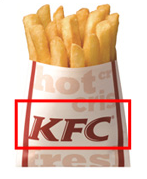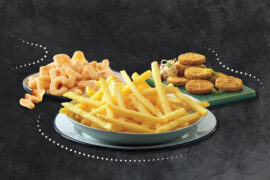While McDonald’s is back on track in Japan as far as availability of french fries on its menus is concerned, Kentucky Fried Chicken’s (KFC) line of supply from value-added potato producers in North America has been derailed to such an extent that the chain has stopped offering the popular side dish for the time being in the Land of the Rising Sun.
“Due to the prolonged dockworkers’ disputes on the United States West Coast, it has become difficult to secure stable supplies of potatoes,” declared a recently issued statement from Colonel Sanders’ KFC Holdings Japan command post in Tokyo. Sales of fries have been temporarily halted at its approximately 1,800 outlets until supply stability is restored.

According to a report in the Journal of Commerce, “Congestion at West Coast ports is the worst it has been since longshoremen began hard-timing employers in early November, and conditions are expected to worsen as terminal operators and the International Longshore and Warehouse Union use manning issues to see how much pain they can inflict on each other.”
During December, McDonald’s Restaurants rationed french fry offerings in Japan, limiting purchases to small sizes only. It reportedly took an airlift of more than 1,000 tons of product to put an end to the “Small Fry Crisis.” Since January 5, customers dining under the Golden Arches have again been able to order any size or quantity they like.
The shortage of fries has sparked a good deal of online commentary, such as this post at the Japan Today website from sigfus45, which suggests shipping more spuds across the Pacific from Western Canada to get around export slowdowns in the US:
“It is only 3,700 nautical miles from Prince Rupert (British Columbia) to Tokyo, the shortest distance from a cargo port in North America to Japan. The french fry potato supplier McCain Foods operates in Canada (they began there), and no doubt has plenty of stock on hand…Some person is desperately slipping if they cannot easily arrange a different port of exit on short notice.”
Another netizen, signing in as LFRAgain, chimed in on January 24:
 “As recently as last week, Mickey D’s Japan had found a way to deal with the potato shortage from the US and is indeed selling fries again, and in all sizes. (I am) not sure how KFC found themselves so unprepared, considering they had months to prepare for this, but as other posters have astutely noted, Japan has a lot of potatoes grown in Hokkaido. Buy them. Slice them. Sell them. Problem solved.”
“As recently as last week, Mickey D’s Japan had found a way to deal with the potato shortage from the US and is indeed selling fries again, and in all sizes. (I am) not sure how KFC found themselves so unprepared, considering they had months to prepare for this, but as other posters have astutely noted, Japan has a lot of potatoes grown in Hokkaido. Buy them. Slice them. Sell them. Problem solved.”
Well, the solution is not quite as simple as that for restaurateurs insisting on maximum quality control.
There are a number of reasons why imports dominate the french fry scene in Japan and in all other major markets of East Asia – including China, where each of the world’s top suppliers from North America and Europe have now established production plants. At the top of the list is quality assurance consistency, followed by a preference for the Russet Burbank potato variety (which the leading American fast food chains established as the norm in Asia decades ago). Next come the economies of scale and efficiencies gained from processing spuds grown on large tracts of fertile farmland located where the climate is ideal.
Shake Shack Warms to Frozen Advantages And then there’s the fact that frozen fries, as well as hash browns and other potato specialties, have proved time and again to be superior to non-frozen products. Consider the recent experience at Shake Shack, for example. The expanding fast-casual restaurant chain, headquartered in New York, abandoned the idea of making fries at its premises with so-called fresh potatoes after achieving far less than satisfactory results.
And then there’s the fact that frozen fries, as well as hash browns and other potato specialties, have proved time and again to be superior to non-frozen products. Consider the recent experience at Shake Shack, for example. The expanding fast-casual restaurant chain, headquartered in New York, abandoned the idea of making fries at its premises with so-called fresh potatoes after achieving far less than satisfactory results.
“About a year ago, we decided to convert [from frozen] our classic crinkle-cut fry to a fresh, hand-cut, Russet potato [fry]…We set out to do what we thought was best and what we believed our guests wanted,” Randy Garutti, chief executive officer and director of Shake Shack, wrote in a open letter to customers dated August 8, 2014. “We learned quickly that sourcing the best potatoes, cutting thousands of them by hand, soaking and double-frying wasn’t easy. But that didn’t stop us. We converted kitchens, added and retrained team members, and successfully launched our hand-cut fries.”
 However, real success in the restaurant business can only be measured by customer satisfaction. And it’s a sure bet that lovers of fries insist on crisp, hot, tasty servings of their favorite potato side dish on a consistent basis. The reality is that consistency in volume is difficult to deliver manually day-in and day-out during peak hours of feeding frenzy. This is the reason why high quality, reliable frozen french fries from specialist suppliers of value-added spuds are preferred by foodservice operators around the world.
However, real success in the restaurant business can only be measured by customer satisfaction. And it’s a sure bet that lovers of fries insist on crisp, hot, tasty servings of their favorite potato side dish on a consistent basis. The reality is that consistency in volume is difficult to deliver manually day-in and day-out during peak hours of feeding frenzy. This is the reason why high quality, reliable frozen french fries from specialist suppliers of value-added spuds are preferred by foodservice operators around the world.
Well-intentioned Shake Shack learned this lesson the democratic way, as consumers and staff alike voted by turning thumbs down to results of the fresh-cut, in-house experiment.
“We weren’t satisfied, and neither were the overwhelming majority of our fans,” confessed Garutti. “No matter how hard we tried, inconsistency remained and we found ourselves unable, 100% of the time, to deliver what our guests loved most about our crinkle cuts…”
“Now with the benefit of hindsight,” he continued, “it’s clear that we underestimated the love for our classic crinkle-cut fry. We reacted to what we thought we heard. But in fact, while listening to a few outspoken critics, we never fully heard the legions of fans that loved our classic crinkle.”
No doubt the operators of KFC and McDonald’s in Japan, a nation where regard for quality is second to none, fully appreciate the tried-and-true advantages of partially-cooked, frozen fries when it comes to consistently serving top-quality product to highly demanding clientele. – Reported by John Saulnier





